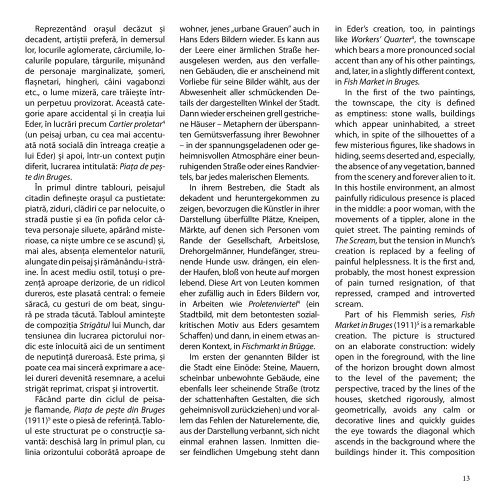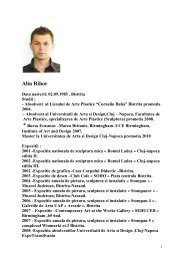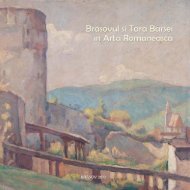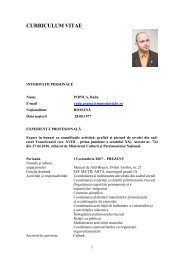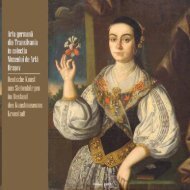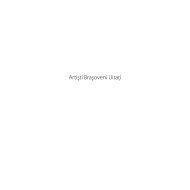Catalog Hans Eder PDF - Muzeul de Arta Brasov
Catalog Hans Eder PDF - Muzeul de Arta Brasov
Catalog Hans Eder PDF - Muzeul de Arta Brasov
Erfolgreiche ePaper selbst erstellen
Machen Sie aus Ihren PDF Publikationen ein blätterbares Flipbook mit unserer einzigartigen Google optimierten e-Paper Software.
Reprezentând oraşul <strong>de</strong>căzut şi<br />
<strong>de</strong>ca<strong>de</strong>nt, artiştii preferă, în <strong>de</strong>mersul<br />
lor, locurile aglomerate, cârciumile, localurile<br />
populare, târgurile, mişunând<br />
<strong>de</strong> personaje marginalizate, şomeri,<br />
flaşnetari, hingheri, câini vagabonzi<br />
etc., o lume mizeră, care trăieşte întrun<br />
perpetuu provizorat. Această categorie<br />
apare acci<strong>de</strong>ntal şi în creaţia lui<br />
<strong>E<strong>de</strong>r</strong>, în lucrări precum Cartier proletar 4<br />
(un peisaj urban, cu cea mai accentuată<br />
notă socială din întreaga creaţie a<br />
lui <strong>E<strong>de</strong>r</strong>) şi apoi, într-un context puţin<br />
diferit, lucrarea intitulată: Piaţa <strong>de</strong> peşte<br />
din Bruges.<br />
În primul dintre tablouri, peisajul<br />
citadin <strong>de</strong>fineşte oraşul ca pustietate:<br />
piatră, ziduri, clădiri ce par nelocuite, o<br />
stradă pustie şi ea (în pofida celor câteva<br />
personaje siluete, apărând misterioase,<br />
ca nişte umbre ce se ascund) şi,<br />
mai ales, absenţa elementelor naturii,<br />
alungate din peisaj şi rămânându-i străine.<br />
În acest mediu ostil, totuşi o prezenţă<br />
aproape <strong>de</strong>rizorie, <strong>de</strong> un ridicol<br />
dureros, este plasată central: o femeie<br />
săracă, cu gesturi <strong>de</strong> om beat, singură<br />
pe strada tăcută. tabloul aminteşte<br />
<strong>de</strong> compoziţia Strigătul lui Munch, dar<br />
tensiunea din lucrarea pictorului nordic<br />
este înlocuită aici <strong>de</strong> un sentiment<br />
<strong>de</strong> neputinţă dureroasă. Este prima, şi<br />
poate cea mai sinceră exprimare a acelei<br />
dureri <strong>de</strong>venită resemnare, a acelui<br />
strigăt reprimat, crispat şi introvertit.<br />
Făcând parte din ciclul <strong>de</strong> peisaje<br />
flaman<strong>de</strong>, Piaţa <strong>de</strong> peşte din Bruges<br />
(1911) 5 este o piesă <strong>de</strong> referinţă. tabloul<br />
este structurat pe o construcţie savantă:<br />
<strong>de</strong>schisă larg în primul plan, cu<br />
linia orizontului coborâtă aproape <strong>de</strong><br />
wohner, jenes „urbane Grauen” auch in<br />
<strong>Hans</strong> <strong>E<strong>de</strong>r</strong>s Bil<strong>de</strong>rn wie<strong>de</strong>r. Es kann aus<br />
<strong>de</strong>r Leere einer ärmlichen Straße herausgelesen<br />
wer<strong>de</strong>n, aus <strong>de</strong>n verfallenen<br />
Gebäu<strong>de</strong>n, die er anscheinend mit<br />
vorliebe für seine Bil<strong>de</strong>r wählt, aus <strong>de</strong>r<br />
Abwesenheit aller schmücken<strong>de</strong>n Details<br />
<strong>de</strong>r dargestellten Winkel <strong>de</strong>r Stadt.<br />
Dann wie<strong>de</strong>r erscheinen grell gestrichene<br />
Häuser – Metaphern <strong>de</strong>r überspannten<br />
Gemütsverfassung ihrer Bewohner<br />
– in <strong>de</strong>r spannungsgela<strong>de</strong>nen o<strong>de</strong>r geheimnisvollen<br />
Atmosphäre einer beunruhigen<strong>de</strong>n<br />
Straße o<strong>de</strong>r eines Randviertels,<br />
bar je<strong>de</strong>s malerischen Elements.<br />
in ihrem Bestreben, die Stadt als<br />
<strong>de</strong>ka<strong>de</strong>nt und heruntergekommen zu<br />
zeigen, bevorzugen die Künstler in ihrer<br />
Darstellung überfüllte plätze, Kneipen,<br />
Märkte, auf <strong>de</strong>nen sich personen vom<br />
Ran<strong>de</strong> <strong>de</strong>r Gesellschaft, Arbeitslose,<br />
Drehorgelmänner, Hun<strong>de</strong>fänger, streunen<strong>de</strong><br />
Hun<strong>de</strong> usw. drängen, ein elen<strong>de</strong>r<br />
Haufen, bloß von heute auf morgen<br />
lebend. Diese Art von Leuten kommen<br />
eher zufällig auch in <strong>E<strong>de</strong>r</strong>s Bil<strong>de</strong>rn vor,<br />
in Arbeiten wie Proletenviertel 4 (ein<br />
Stadtbild, mit <strong>de</strong>m betontesten sozialkritischen<br />
Motiv aus <strong>E<strong>de</strong>r</strong>s gesamtem<br />
Schaffen) und dann, in einem etwas an<strong>de</strong>ren<br />
Kontext, in Fischmarkt in Brügge.<br />
im ersten <strong>de</strong>r genannten Bil<strong>de</strong>r ist<br />
die Stadt eine Einö<strong>de</strong>: Steine, Mauern,<br />
scheinbar unbewohnte Gebäu<strong>de</strong>, eine<br />
ebenfalls leer scheinen<strong>de</strong> Straße (trotz<br />
<strong>de</strong>r schattenhaften Gestalten, die sich<br />
geheimnisvoll zurückziehen) und vor allem<br />
das Fehlen <strong>de</strong>r Naturelemente, die,<br />
aus <strong>de</strong>r Darstellung verbannt, sich nicht<br />
einmal erahnen lassen. inmitten dieser<br />
feindlichen Umgebung steht dann<br />
in <strong>E<strong>de</strong>r</strong>’s creation, too, in paintings<br />
like Workers’ Quarter 4 , the townscape<br />
which bears a more pronounced social<br />
accent than any of his other paintings,<br />
and, later, in a slightly different context,<br />
in Fish Market in Bruges.<br />
in the first of the two paintings,<br />
the townscape, the city is <strong>de</strong>fined<br />
as emptiness: stone walls, buildings<br />
which appear uninhabited, a street<br />
which, in spite of the silhouettes of a<br />
few misterious figures, like shadows in<br />
hiding, seems <strong>de</strong>serted and, especially,<br />
the absence of any vegetation, banned<br />
from the scenery and forever alien to it.<br />
in this hostile environment, an almost<br />
painfully ridiculous presence is placed<br />
in the middle: a poor woman, with the<br />
movements of a tippler, alone in the<br />
quiet street. the painting reminds of<br />
The Scream, but the tension in Munch’s<br />
creation is replaced by a feeling of<br />
painful helplessness. it is the first and,<br />
probably, the most honest expression<br />
of pain turned resignation, of that<br />
repressed, cramped and introverted<br />
scream.<br />
part of his Flemmish series, Fish<br />
Market in Bruges (1911) 5 is a remarkable<br />
creation. the picture is structured<br />
on an elaborate construction: wi<strong>de</strong>ly<br />
open in the foreground, with the line<br />
of the horizon brought down almost<br />
to the level of the pavement; the<br />
perspective, traced by the lines of the<br />
houses, sketched rigorously, almost<br />
geometrically, avoids any calm or<br />
<strong>de</strong>corative lines and quickly gui<strong>de</strong>s<br />
the eye towards the diagonal which<br />
ascends in the background where the<br />
buildings hin<strong>de</strong>r it. this composition


